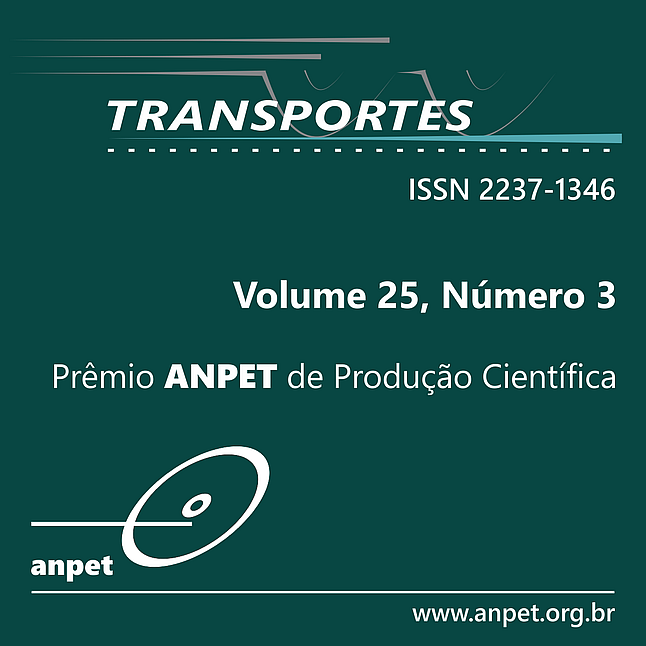Análise e visualização de dados de rastreamento para caracterização da logística urbana
DOI:
https://doi.org/10.14295/transportes.v25i3.1353Keywords:
Urban logistics, Geospatial big data, GPS data, Data visualization.Abstract
This study aims to apply GPS (Global Positioning System) data analysis and visualization techniques in order to understand the urban logistics' behavior in some cities of Brazil, through logistical indicators such as distribution of delivery points, volume of distribution of trucks over time (day and time of day), etc. For that, two distinct databases of vehicle tracking were used: the first provided by two large retailers that already had such data for risk management and monitoring of drivers' behavior; and the second one belongs to a map services provider whose data is derived from several companies, mostly vehicle tracking companies. To process this amount of data, it was necessary to use geospatial big data analysis tools. In both databases, it was possible to analyze, for the period 06-10 of October 2014 (Monday to Friday), the volume distribution pattern per day, and the results point to a smaller volume of vehicles circulating on Monday in comparison to other working days (Tuesday to Friday).Downloads
References
Bontempo, A.P.; C.B. Cunha; D.A. Botter e H.T.Y. Yoshizaki (2014) Evaluating Restrictions on the Circulation of Freight Vehicles in Brazilian Cities. Procedia - Social and Behavioral Sciences, 125, p. 275-283. DOI:/10.1016/j.sbspro.2014.01.1473
CET-SP (2015) Pesquisa de Monitoração da Mobilidade no Sistema Viário Principal. Companhia de Engenharia de Tráfego de São Paulo, São Paulo, SP.
Chi, E.H. (2000) A taxonomy of visualization techniques using the data state reference model. Proceedings of the IEEE Symposium on Information Visualization InfoVis, IEEE Computer Society, Washington, DC, USA, p. 69–76. DOI:/10.1109/INFVIS.2000.885092
Dablanc, L. e D. Rakotonarivo (2010) The impacts of logistics sprawl: How does the location of parcel transport terminals affect the energy efficiency of goods’ movements in Paris and what can we do about it?. Procedia-Social and Behavioral Sciences, 2(3), p. 6087-6096. DOI:/10.1016/j.sbspro.2010.04.021
Dorling, D.; A. Barford e M. Newman (2006) WORLDMAPPER: The world as you've never seen it before. IEEE transactions on visualization and computer graphics, 12(5), p. 757-764. DOI:/10.1109/TVCG.2006.202
Greaves, S. P. e M. A. Figliozzi (2008) Commercial Vehicle Tour Data Collection Using Passive GPS Technology: Issues and Potential Applications. Institute of Transport and Logistics Studies.
Joubert, J. W. e S. Meintjes (2015) Repeatability & reproducibility: Implications of using GPS data for freight activity chains. Transportation Research Part B: Methodological, 76, p. 81-92. DOI:/10.1016/j.trb.2015.03.007
Kraak, M-J. e F. Ormeling (2011) Cartography: Visualization of Spatial Data, Guilford Press.
Lee, J-G e M. Kang (2015) Geospatial Big Data: Challenges and Opportunities.Big Data Research, v.2, p. 74-81. DOI: /10.1016/j.bdr.2015.01.003
Loidl, M.; G. Wallentin; R. Cyganski; A. Graser; J. Scholz e E. Haslauer (2016) GIS and Transport Modeling—Strengthening the Spatial
Perspective. ISPRS International Journal of Geo-Information. DOI:/10.3390/ijgi5060084
Nanni, M. (2013) Mobility Data Mining. Cambridge: Cambridge University Press. DOI:/10.1017/CBO9781139128926
Schumann, H. e C. Tominski (2011) Analytical, visual and interactive concepts for geo-visual analytics. Journal of Visual Languages and Computing 22, p. 257-267. DOI:/10.1016/j.jvlc.2011.03.002
Spaccapietra, S.; C. Parent e L. Spinsanti (2013) Trajectories and Their Representations. Cambridge University. DOI:/10.1017/CBO9781139128926.002
Tominski, C.; P. Schulze-Wollgast e H. Schumann (2005) 3D information visualization for time dependent data on maps. In Ninth International Conferenceon Information Visualisation, p. 175-181. IEEE. DOI:/10.1109/IV.2005.3
Downloads
Published
How to Cite
Issue
Section
License
Authors who submit papers for publication by TRANSPORTES agree to the following terms:
- The authors retain the copyright and grant Transportes the right of first publication of the manuscript, without any financial charge, and waive any other remuneration for its publication by ANPET.
- Upon publication by Transportes, the manuscript is automatically licensed under the Creative Commons License CC BY 4.0 license. This license permits the work to be shared with proper attribution to the authors and its original publication in this journal.
- Authors are authorized to enter into additional separate contracts for the non-exclusive distribution of the version of the manuscript published in this journal (e.g., publishing in an institutional repository or as a book chapter), with recognition of the initial publication in this journal, provided that such a contract does not imply an endorsement of the content of the manuscript or the new medium by ANPET.
- Authors are permitted and encouraged to publish and distribute their work online (e.g., in institutional repositories or on their personal websites) after the editorial process is complete. As Transportes provides open access to all published issues, authors are encouraged to use links to the DOI of their article in these cases.
- Authors confirm they have obtained all required employer permissions for the publication and CC BY 4.0 licensing of the manuscript, particularly if the employer holds any claim to the manuscript's copyright. Authors assume all responsibility for employer-related copyright issues, releasing ANPET and Transportes from any related liability.
- Authors assume full responsibility for the content of the manuscript, including the necessary and appropriate authorizations for the disclosure of collected data and obtained results, releasing ANPET and Transportes from any responsibility in this regard.
Last update: 11/27/2025











